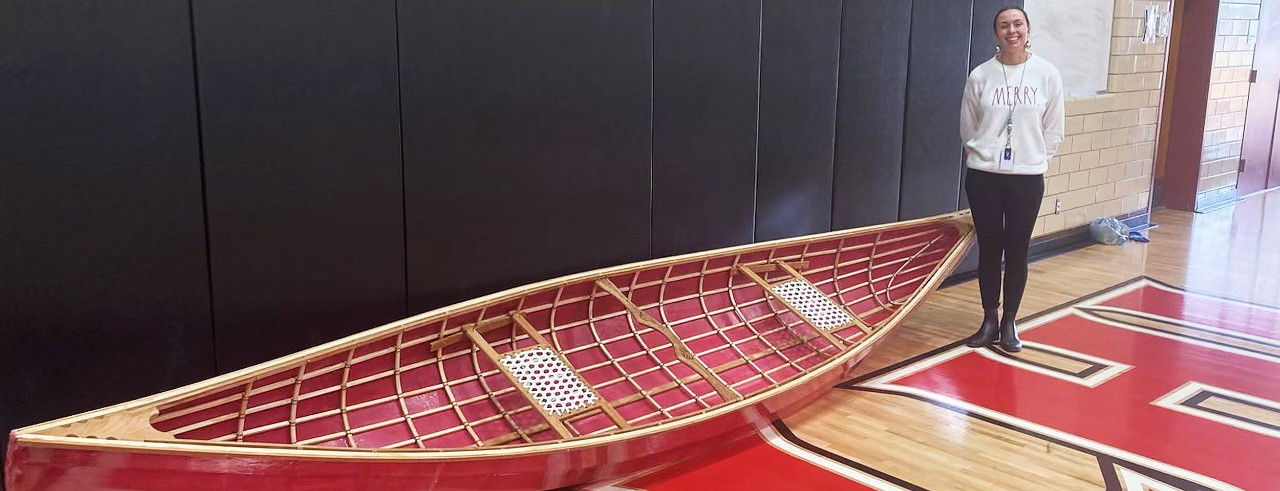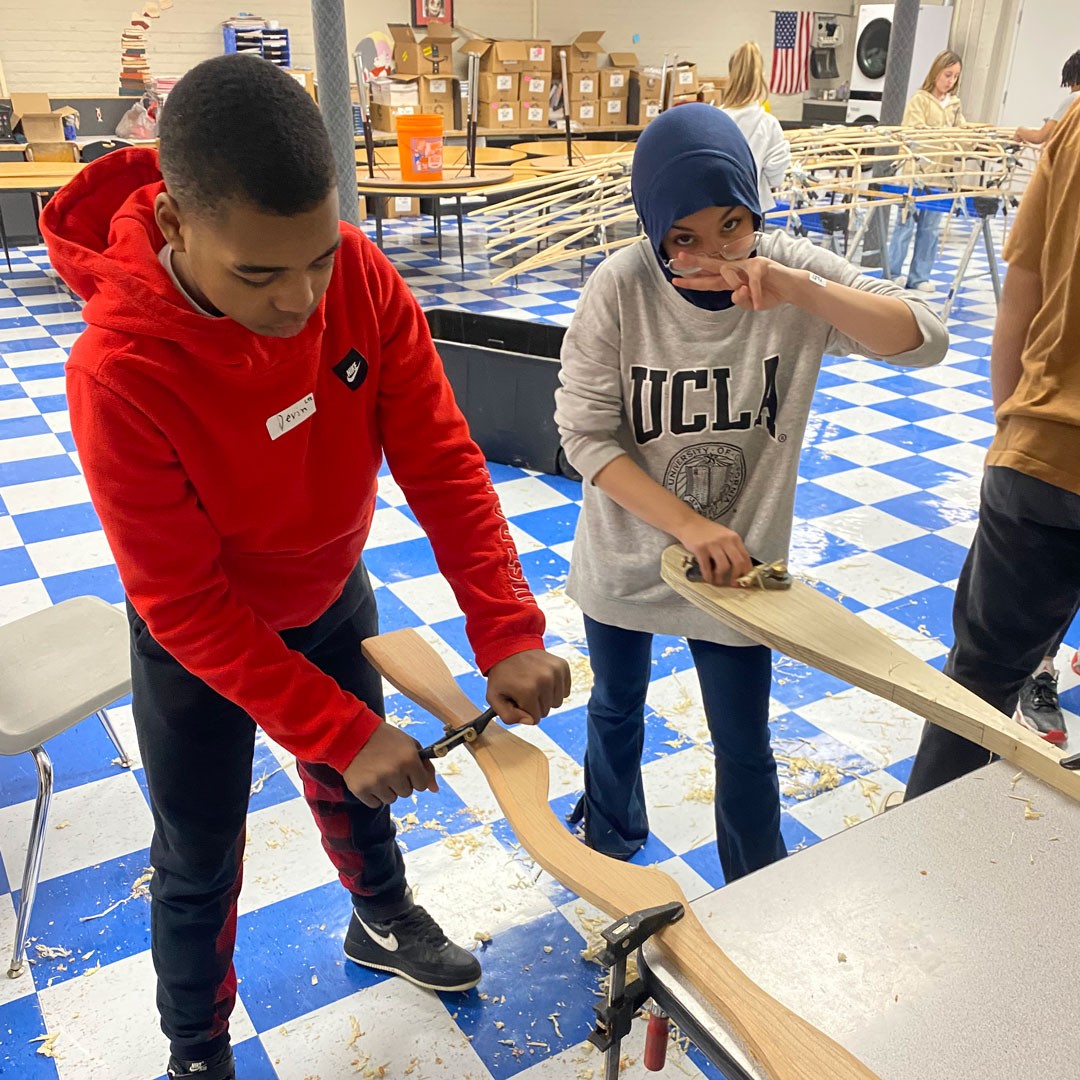
Off the page, into the water: UC alum and seventh-grade teacher teaches through canoe building
The Delhi Middle School teacher initiated a special learning program in her middle school classroom.
Emily Hohlefelder knows the importance of digital platforms in today’s learning environments. A seventh-grade teacher at Delhi Middle School, Hohlefelder has experienced the impact of digital connectivity on education both in the classroom and during her own time as a student at the University of Cincinnati.
“There are so many platforms!” says Hohlefelder, pointing to the lasting impact COVID-19 and remote learning had on teaching and learning. “So many different ones, all asking students to present their information in different ways: recording themselves, recording just their voice or having to create some sort of digital image.”

Students in Emily Hohlefelder's seventh-grade class work on the frame of the skin-on frame canoe. Photo/provided
None of this is news to the 2023 graduate of the College of Education, Criminal Justice, Human Services, and Information Technology, who was introduced to future-forward teaching tools during her first year as an undergraduate in the Middle Childhood Education program. Specifically, it was an educational technology class with School of Education professor Sarah Schroeder that opened Hohlefelder’s eyes to the possibilities of instruction and learning in a hyper-connected, always-on world.
She also honed in on how platforms, especially interfaces for creative student work, can cause anxiety in some students, leading Hohlefelder to complete and submit a project on reducing student anxiety around technology use. Schroeder was impressed with Hohlefelder’s insights and invited the first-year student to present her research at the Ohio Undergraduate Technology conference in Columbus.
“I was like, ‘Sure, I’ll go with you!’” laughs Hohlefelder, who went on to become dual-licensed in middle childhood and special education with a certificate in digital learning design. “I felt pretty underqualified – I was 19 and in my first year, but she took a chance on me.” Schroeder subsequently helped Hohlefelder publish her work as well, co-authoring a paper titled “Reducing Student Anxiety About Creative Digital Work” for publication in Edutopia, an online outlet for educational news and insight.
“I ended up doing a grant-funded project on reducing student anxiety with technology while I was an undergrad. It fueled a lot of great new information, especially coming out of COVID, on how technology can cause a lot of anxiety when it comes to different methods of learning for students.”
Building Life Skills (and a Canoe)
Proven expertise with technology and insight into digital platforms might make Hohlefelder an unlikely champion for hands-on, nature-focused learning. But for a person with a lifelong ambition to help all learners reach their potential, she works to stay alert to opportunities that expand her ability to reach pupils – which is how she ended up bringing a canoe-building project into her classroom.
“The director of the program is one of my good friends,” says Hohlefleder. “I had watched him go into schools for the past three years, so why wouldn’t I want to bring this into my own school?” The Urban Wilderness Program, she goes on to explain, is a Cincinnati-based non-profit that delivers wilderness experiences to schools with kids who, demographically, don’t enjoy easy access to outdoor enrichment.
“A lot of my students had not been in a canoe before. They had not been on a body of water.”
Emily Hohlefelder, Seventh-grade teacher at Delhi Middle School

Seventh-grade Delhi Middle School students shape parts for the classroom canoe build. Photo/provided
The STEM-based project saw students construct a skin-on frame canoe as part of their daily classwork, which Hohlefelder was able to tie into traditional areas of study such as math and science, as well as social studies and language arts. “At the same time, they were able to learn teamwork, critical thinking skills and how to work together to pursue a common goal,” she says. “And it always helps students, especially in middle school, when that goal is tangible. So fostering that kind of community was truly the goal we were looking for here at Delhi with the canoe build.”
Another significant benefit of the classroom canoe project? The collaborative build provided a holistic means to reach students who sometimes struggled to engage with learning material. “It was fun to see kids who were usually reserved or not interested in the academic setting of the classroom really come out of their shell when it came to getting to use their hands for something,” explains Hohlefelder. “The build takes about two weeks, so it becomes routine for them. A lot of them really enjoyed it.”
A Risk Worth the Reward
The canoe-build project was, admittedly, a big swing – especially for a teacher so early in their career (this is, in fact, Hohlefelder’s first year teaching at Delhi Middle School). But that same spirit she found during her first year, when she said yes to the conference opportunity in Columbus despite feeling underqualified, spurred her to take the chance.
“As teachers, we already have a million things going on,” she says. “And trying something for the first time? I’m like, this could fail – this could go very badly. But it’s worth taking the risk if it’s going to benefit the students.”

A student connects planking to one of the ribs on the canoe frame. Photo/provided
The canoe is currently on display (alongside a pair of oars carved as part of the program) in the school, but Hohlefelder envisions this canoe build as an annual seventh-grade project that, in time, populates a nearby pond with a fleet for public use. And though the students didn’t know it when they initially built the canoe, there is a part two to this project they recently learned about – a May field trip in which they themselves will take the canoe out for some freshwater fun.
“We have to teach them, at the end of the day, that it’s not about the tests,” says Hohlefelder. “It’s not about the data. It’s really about what kind of people we are teaching here. How are we teaching them to serve the community when they’re older?
“Projects like these are the ones that I know they’ll remember past middle school.”
Featured image at top: Emily Hohlefelder stands next to completed skin-on frame canoe built as a seventh-grade classroom project. Photo/provided.
Next Lives Here
CECH’s School of Education is highly regarded for preparing the next generation of educators. The program is led by a team of experienced and qualified faculty who are dedicated to teaching students to meet the demands of modern classrooms and address the educational needs of diverse student populations. The program offers a variety of courses and experiences that will help students develop their understanding of child development, instructional methods, and classroom management.
For more information about the School of Education, please visit the school’s website.
Contact the College of Education, Criminal Justice, Human Services, and Information Technology.
Related Stories
Off the page, into the water: UC alum and seventh-grade teacher teaches through canoe building
April 11, 2024
Emily Hohlefelder, a 7th-grade teacher at Delhi Middle School, applied lessons she learned as a UC education student in the College of Education, Criminal Justice, Human Services, and Information Technology (CECH) to initiate a special learning program in the classroom. The result? A canoe-building project that proved both educational and uniquely engaging.
Teacher appreciation in action with UC Alumni Association
May 29, 2024
The University of Cincinnati’s Alumni Association visited alumni of the School of Education at their workplaces with gifts of gratitude. Program Director of Alumni Engagement Gage Woolley set out with representatives from the College of Education, Criminal Justice, Human Services, and Information Technology (CECH) to deliver small bags filled with UC-themed goodies to teachers at UC's Arlitt Child Development Center and four different locations across the Cincinnati Public School District (Silverton Elementary, Pleasant Ridge Montessori, Shroder High and Woodford Academy).
Amid shift to remote learning, UC students emerge ed tech leaders
July 10, 2020
When area schools scrambled to move instruction online due to the COVID-19 pandemic, UC education students stepped up to help teachers adapt their lesson plans online.
